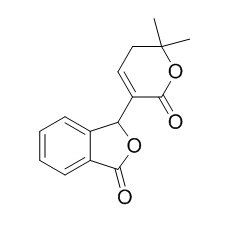Catalpalactone
Catalpalactone exhibits high antitermitic, and cytotoxic activities, it exhibits potent inhibitory effects on lipopolysaccharide-induced NO synthesis in RAW 264.7 cells , with IC50 values of 9.80 microM. Catalpalactone can inhibit dopamine biosynthesis by reducing tyrosine hydroxylase (TH) and aromatic-l-amino acid decarboxylase (AADC) activities and enhance L-DOPA- induced cytotoxiciy in PC12 cells. Catalpalactone also exhibits significant inhibitory activity against 12-O-tetradecanoylphorbol 13-acetate (TPA)-induced Epstein-Barr virus early antigen (EBV-EA) activation in Raji cells.
Inquire / Order:
manager@chemfaces.com
Technical Inquiries:
service@chemfaces.com
Tel:
+86-27-84237783
Fax:
+86-27-84254680
Address:
1 Building, No. 83, CheCheng Rd., Wuhan Economic and Technological Development Zone, Wuhan, Hubei 430056, PRC
Providing storage is as stated on the product vial and the vial is kept tightly sealed, the product can be stored for up to
24 months(2-8C).
Wherever possible, you should prepare and use solutions on the same day. However, if you need to make up stock solutions in advance, we recommend that you store the solution as aliquots in tightly sealed vials at -20C. Generally, these will be useable for up to two weeks. Before use, and prior to opening the vial we recommend that you allow your product to equilibrate to room temperature for at least 1 hour.
Need more advice on solubility, usage and handling? Please email to: service@chemfaces.com
The packaging of the product may have turned upside down during transportation, resulting in the natural compounds adhering to the neck or cap of the vial. take the vial out of its packaging and gently shake to let the compounds fall to the bottom of the vial. for liquid products, centrifuge at 200-500 RPM to gather the liquid at the bottom of the vial. try to avoid loss or contamination during handling.
Separations2023, 10(4),255.
Development.2024, 151(20):dev202518.
Pak J Pharm Sci.2019, 32(6):2879-2885
Horticulture Research2022, uhac276.
Separations2023, 10(4), 231.
J Nat Prod.2021, 84(9):2544-2553.
Curr Res Food Sci.2024, 9:100896.
Res Rep Urol.2022, 14:313-326.
Life Sci.2019, 216:259-270
Int J Mol Sci.2024, 25(16):8846.
Related and Featured Products
Bisacurone
Catalog No: CFN96432
CAS No: 120681-81-4
Price: $318/20mg
Bisacurone C
Catalog No: CFN89015
CAS No: 127214-86-2
Price: Inquiry(manager@chemfaces.com)
3-Hydroxybisabola-1,10-dien-9-one
Catalog No: CFN89024
CAS No: 129673-86-5
Price: Inquiry(manager@chemfaces.com)
3,4-Dihydroxybisabola-1,10-diene
Catalog No: CFN89025
CAS No: 129673-87-6
Price: Inquiry(manager@chemfaces.com)
1,4-Epidioxybisabola-2,10-dien-9-one
Catalog No: CFN89249
CAS No: 170380-69-5
Price: Inquiry(manager@chemfaces.com)
Bisabola-3,10-dien-2-one
Catalog No: CFN89224
CAS No: 61432-71-1
Price: Inquiry(manager@chemfaces.com)
1-Hydroxybisabola-2,10-dien-4-one
Catalog No: CFN96995
CAS No: 1213251-45-6
Price: Inquiry(manager@chemfaces.com)
4-(6-Methyl-4-oxohept-5-en-2-yl)cyclohex-2-en-1-one
Catalog No: CFN89244
CAS No: 170380-68-4
Price: Inquiry(manager@chemfaces.com)
9-Oxo-2,7-bisaboladien-15-oic acid
Catalog No: CFN97512
CAS No: 93888-59-6
Price: Inquiry(manager@chemfaces.com)
4-Hydroxy-1,10-secocadin-5-ene-1,10-dione
Catalog No: CFN96371
CAS No: 226904-40-1
Price: Inquiry(manager@chemfaces.com)
Environ Toxicol Pharmacol. 2008 Jul;26(1):86-91.
Effects of catalpalactone on dopamine biosynthesis and L-DOPA-induced cytotoxicity in PC12 cells.[Pubmed:
21783893]
The effects of Catalpalactone on dopamine biosynthesis and L-DOPA-induced cytotoxicity in PC12 cells were investigated.
METHODS AND RESULTS:
Catalpalactone at 5-30μM decreased intracellular dopamine content with the IC(50) value of 22.1μM. Catalpalactone at 5-20μM, but not 30μM, did not alter cell viability. Catalpalactone at 20μM inhibited tyrosine hydroxylase (TH) and aromatic-l-amino acid decarboxylase (AADC) activities. Catalpalactone also decreased cyclic AMP levels and inhibited TH phosphorylation. In addition, Catalpalactone at 20μM reduced the increases in dopamine levels induced by L-DOPA (20-50μM). Catalpalactone (5-30μM) associated with L-DOPA (50-100μM) enhanced L-DOPA-induced cytotoxicity at 48h, which was prevented by N-acetyl-l-cysteine.
CONCLUSIONS:
These results suggest that Catalpalactone inhibited dopamine biosynthesis by reducing TH and AADC activities and enhanced L-DOPA-induced cytotoxiciy in PC12 cells.
Arch Pharm Res. 2010 Mar;33(3):381-5.
Naphthoquinones from Catalpa ovata and their inhibitory effects on the production of nitric oxide.[Pubmed:
20361302]
METHODS AND RESULTS:
Bioassay-guided fractionation of a CH2Cl2-soluble fraction of the stems of Catalpa ovata led to isolation of a new naphthoquinone, 4-hydroxy-2-(2-methoxy-3-hydroxy-3-methyl-but-1-enyl)-4-hydro-1H-naphthalen-1-one (10), together with nine known compounds, catalponol (1), catalponone (2), Catalpalactone (3), alpha-lapachone (4), 9-hydroxy-alpha-lapachone (5), 4,9-dihydroxy-alpha-lapachone (6), 9-methoxy-alpha-lapachone (7), 4-oxo-alpha-lapachone (8), and 9-methoxy-4-oxo-alpha-lapachone (9). The structures were elucidated on the basis of spectroscopic analyses. The inhibitory effects of these isolates on lipopolysaccharide-induced NO synthesis in RAW 264.7 cells were evaluated.
CONCLUSIONS:
Among them, catapalactone (3), 9-hydroxy-alpha-lapachone (5) and 4,9-dihydroxy-alpha-lapachone (6) exhibited potent inhibitory effects, with IC(50) values of 9.80, 4.64 and 2.73 microM, respectively.
J Chem Ecol. 1992 Mar;18(3):359-69.
Major antitermitic components of the heartwood of southern catalpa.[Pubmed:
24254942]
METHODS AND RESULTS:
A structurally related ketone, catalponone (1%); and the phthalide, Catalpalactone (25%). Pure compounds were isolated by semipreparative scale reversed-phase HPLC and identified by GC-MS and UV spectroscopy. The structure of catalponol was further confirmed by the formation of derivatives.
CONCLUSIONS:
Bioassays indicated that catalponol had the greatest toxicity in cellulose pad tests, but in tests using vacuum impregnation of these compounds into termite-susceptible wood blocks at levels approximating those found in catalpa heartwood, Catalpalactone exhibited the highest antitermitic activity.
J Nat Prod. 1998 May;61(5):629-32.
Antitumor-promoting naphthoquinones from Catalpa ovata.[Pubmed:
9599262]
METHODS AND RESULTS:
Bioassay-directed fractionation of an extract of the stem-bark of Catalpa ovata led to the isolation of three new naphthoquinones: 8-methoxydehydroiso-alpha-lapachone (1), 9-methoxy-4-oxo-alpha-lapachone (2), and (4S,4aR,10R,10aR)-4, 10-dihydroxy-2,2-dimethyl-2,3,4,4alpha,10, 10alpha-hexahydrobenzo[g]chromen-5-one (3), which is a 1,4-reductive form of 6. The known compounds 3-hydroxydehydroiso-alpha-lapachone (4), 4,9-dihydroxy-alpha-lapachone (5), 4-hydroxy-alpha-lapachone (6), and 9-methoxy-alpha-lapachone (7), and Catalpalactone (8) were also isolated. Their structures were elucidated by spectral methods.
CONCLUSIONS:
These compounds all exhibited significant inhibitory activity against 12-O-tetradecanoylphorbol 13-acetate (TPA)-induced Epstein-Barr virus early antigen (EBV-EA) activation in Raji cells.
Periodical of Ocean University of China, 2012, 42: 127-45.
An Improved Synthesis and Cytotoxicity Activities of Catalpalactone[Reference:
WebLink]
METHODS AND RESULTS:
An improved synthesis of Catalpalactone was carried out with a total yield of 18% by using 2-formylbenzoic acid as the starting material followed by a four-steps procedure including Wittig reaction,lactonization,retro-Michael addition and a one-pot manipulation to introduce the double bond.The structures of all of the intermediates as well as the stereo-configurations of double bond in compounds 11,12a and 12b were determined by 1H NMR,13C NMR,MS,1H-1H COSY and NOE techniques.This improved synthetic method provides several advantages such as inexpensive and easily available reagents,mild reaction conditions,simple operations,and high yields.
CONCLUSIONS:
Through being evaluated in vitro against a panel of two human tumor cell lines(MCF-7,BxPC3) which were determined by the SRB assays, Catalpalactone displayed good activities against MCF-7 and BxPC3.



